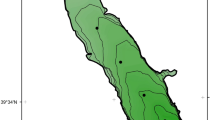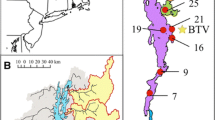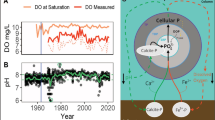Abstract
Climate change is predicted to have widespread impacts on freshwater lake and reservoir nutrient budgets by altering both hypolimnetic hypoxia and runoff, which will in turn alter the magnitude of internal and external nutrient loads. To examine the effects of these potential climate scenarios on nitrogen (N) and phosphorus (P) budgets, we conducted a whole-catchment manipulation of hypolimnetic oxygen conditions and external loads to Falling Creek Reservoir (FCR), an old, eutrophic reservoir in a reforested catchment with a history of agricultural land use. Throughout 2 years of monitoring, internal N and P loading during hypoxic conditions dominated the hypolimnetic mass of nutrients in FCR, regardless of changes in external loading. FCR commonly functioned as a net sink of N and P, except during hypoxic conditions, when the reservoir was a net source of ammonium (\( {\text{NH}}_{4}^{ + } \)) to downstream. We observed extremely high nitrate–nitrite (\( {\text{NO}}_{3}^{ - } {-}{\text{NO}}_{2}^{ - } \)), soluble reactive P (SRP), total nitrogen (TN), and total phosphorus (TP) retention rates, indicating that the reservoir served as a sink for greater than 70% of \( {\text{NO}}_{3}^{ - } {-}{\text{NO}}_{2}^{ - } \) inputs and greater than 30% of SRP, TN, and TP inputs, on average. Our study is notable in the length of time since reforestation (>80 years) that a reservoir is still exhibiting high N and P internal loading during hypoxia, potentially as a result of the considerable store of accumulated nutrients in its sediment from historical agricultural runoff. Our whole-catchment manipulations highlight the importance of understanding how multiple aspects of global change, waterbody and catchment characteristics, and land use history will interact to alter nutrient budgets in the future.









Similar content being viewed by others
References
Adrian R, O’Reilly CM, Zagarese H, Baines SB, Hessen DO, Keller W, Livingstone DM, Sommaruga R, Straile D, Van Donk E, Weyhenmeyer GA, Winder M. 2009. Lakes as sentinels of climate change. Limnol Oceanogr 54:2283–97.
Beaulac MN, Reckhow KH. 1982. An examination of land use—nutrient export relationships. Water Resour Bull 18:1013–24.
Bindoff NL, Stott PA, AchutaRao KM, Allen MR, Gillett N, Gutzler D, Hansingo K, Hegerl G, Hu Y, Jain S, Mokhov II, Overland J, Perlwitz J, Sebbari R, Zhang X. 2013. Detection and attribution of climate change: from global to regional. In: Stocker TF, Qin D, Plattner G-K, Tignor M, Allen SK, Boschung J, Nauels A, et al., Eds. Climate change 2013: the physical science basis. Contribution of WG I to the 5th Assessment Report of the IPCC. New York.
Boström B, Andersen JM, Fleischer S, Jansson M. 1988. Exchange of phosphorus across the sediment-water interface. Hydrobiologia 170:229–44.
Bruesewitz DA, Tank JL, Hamilton SK. 2012. Incorporating spatial variation of nitrification and denitrification rates into whole-lake nitrogen dynamics. J Geophys Res 117:1–12.
Burgin AJ, Hamilton SK. 2007. Have we overemphasized the role of denitrification in aquatic ecosystems? A review of nitrate removal pathways. Front Ecol Environ 5:89–96.
Canfield DE, Glazer AN, Falkowski PG. 2010. The evolution and future of earth’s nitrogen cycle. Science 330:192–6.
Carpenter SR. 1996. Microcosm experiments have limited relevance for community and ecosystem ecology. Ecology 77:677–80.
Carpenter SR, Chisholm SW, Krebs CJ, Schindler DW, Wright RF. 1995. Ecosystem experiments. Science 269:324–7.
Conley DJ, Paerl HW, Howarth RW, Boesch DF, Seitzinger SP, Havens KE, Lancelot C, Likens GE. 2009. Controlling eutrophication: nitrogen and phosphorus. Science 323:1014–15.
David MB, Wall LG, Royer TV, Tank JL. 2006. Denitrification and the nitrogen budget of a reservoir in an agriculture landscape. Ecol Appl 16:2177–90.
Downing JA, Prairie YT, Cole JJ, Duarte CM, Tranvik LJ, Striegl RG, McDowell RW, Kortelainen P, Caraco NF, Melack J, Middelburg JJ. 2006. The global abundance and size distribution of lakes, ponds, and impoundments. Limnol Oceanogr 51:2388–97.
Easterling DR, Meehl GA, Parmesan C, Changnon SA, Karl TR, Mearns LO. 2000. Climate extremes: observations, modeling, and impacts. Science 289:2068–74.
Einsele W. 1936. Über die Beziehung des Eisenkreislaufs zum Phosphorkreislauf im eutrophen. See Arch Hydrobiol 29:664–86.
Essington TE, Carpenter SR. 2000. Nutrient cycling in lakes and streams: insights from a comparative analysis. Ecosystems 3:131–43.
Foster D, Swanson F, Aber J, Burke I, Brokaw N, Tilman D, Knapp A. 2003. The importance of land-use legacies to ecology and conservation. BioScience 53:77–89.
Gerling AB, Browne RG, Gantzer PA, Mobley MH, Little JC, Carey CC. 2014. First report of the successful operation of a side stream supersaturation hypolimnetic oxygenation system in a eutrophic, shallow reservoir. Water Res 67:129–43.
Harding JS, Benfield EF, Bolstad PV, Helfman GS, Jones EBD. 1998. Stream biodiversity: The ghost of land use past. Proc Natl Acad Sci USA 95:14843–7.
Harrison JA, Maranger RJ, Alexander RB, Giblin AE, Jacinthe P-A, Mayorga E, Seitzinger SP, Sobota DJ, Wollheim WM. 2009. The regional and global significance of nitrogen removal in lakes and reservoirs. Biogeochemistry 93:143–57.
Jeppesen E, Kronvang B, Meerhoff M, Sondergaard M, Hansen KM, Andersen HE, Lauridsen TL, Liboriussen L, Beklioglu M et al. 2009. Climate change effects on runoff, catchment phosphorus loading and lake ecological state, and potential adaptations. J Environ Qual 38:1930–41.
Jeppesen E, Kronvang B, Olesen JE, Audet J, Sondergaard M, Hoffmann CC, Andersen HE, Lauridsen TL, Liboriussen L, Larsen SE, Beklioglu M, Meerhoff M, Ozen A, Ozkan K. 2011. Climate change effects on nitrogen loading from cultivated catchments in Europe: implications for nitrogen retention, ecological state of lakes and adaptation. Hydrobiologia 663:1–21.
Jiménez Cisneros BE, Oki T, Arnell NW, Benito G, Cogley JG, Döll P, Jiang T, Mwakalila SS. 2014. Freshwater resources. In: Field CB, et al., Eds. Climate change 2014: impacts, adaptation, and vulnerability. Contribution of WGII to the 5th assessment report of the IPCC. New York.
Kelly VJ. 2001. Influence of reservoirs on solute transport: a regional-scale approach. Hydrol Process 15:1227–49.
Knowles R. 1982. Denitrification. Microbiol Rev 46:43–70.
Kõiv T, Nõges T, Laas A. 2011. Phosphorus retention as a function of external loading, hydraulic turnover time, area and relative depth in 54 lakes and reservoirs. Hydrobiologia 660:105–15.
Koop-Jakobsen K, Giblin AE. 2010. The effect of increased nitrate loading on nitrate reduction via denitrification and DNRA in salt marsh sediments. Limnol Oceanogr 55:789–802.
Leavitt PR, Brock CS, Ebel C, Patoine A. 2006. Landscape-scale effects of urban nitrogen on a chain of freshwater lakes in central North America. Limnol Oceanogr 51:2262–77.
Min SK, Zhang X, Zwiers FW, Hegerl GC. 2011. Human contribution to more-intense precipitation extremes. Nature 470:378–81.
Molot LA, Dillon PJ. 1993. Nitrogen mass balances and denitrification rates in central Ontario Lakes. Biogeochemistry 20:195–212.
Mortimer CH. 1941. The exchange of dissolved substances between mud and water in lakes. J Ecol 29:280–329.
Nowlin WH, Evarts JL, Vanni MJ. 2005. Release rates and potential fates of nitrogen and phosphorus from sediments in a eutrophic reservoir. Freshw Biol 50:301–22.
Palmer ME, Yan ND, Somers KM. 2014. Climate change drives coherent trends in physics and oxygen content in North American lakes. Clim Change 124:285–99.
Patoine A, Graham MD, Leavitt PR. 2006. Spatial variation of nitrogen fixation in lakes of the northern Great Plains. Limnol Oceanogr 51:1665–77.
Powers SM, Julian JP, Doyle MW, Stanley EH. 2013. Retention and transport of nutrients in a mature agricultural impoundment. J Geophys Res Biogeosci 118:91–103.
Powers SM, Tank JL, Robertson DM. 2015. Control of nitrogen and phosphorus transport by reservoirs in agricultural landscapes. Biogeochemistry 124:417–39.
Renwick WH, Smith SV, Bartley JD, Buddemeier RW. 2005. The role of impoundments in the sediment budget of the conterminous United States. Geomorphology 71:99–111.
Rosenberg DM, McCully P, Pringle CM. 2000. Global-scale environmental effects of hydrological alterations: introduction. BioScience 50:746–51.
Rydin E. 2000. Potentially mobile phosphorus in Lake Erken sediment. Water Res 34:2037–42.
Sahoo GB, Schladow SG, Reuter JE, Coats R. 2010. Effects of climate change on thermal properties of lakes and reservoirs, and possible implications. Stoch Environ Res Risk A 25:445–56.
Salas HJ, Martino P. 1991. A simplified phosphorus trophic state model for warm-water tropical lakes. Water Res 25:341–50.
Schindler DW, Hecky RE, Findlay DL, Stainton MP, Parker BR, Paterson MJ, Beaty KG, Lyng M, Kasian SE. 2008. Eutrophication of lakes cannot be controlled by reducing nitrogen input: results of a 37-year whole-ecosystem experiment. Proc Natl Acad Sci USA 105:11254–8.
Shostell J, Bukaveckas PA. 2004. Seasonal and interannual variation in nutrient fluxes from tributary inputs, consumer recycling and algal growth in a eutrophic river impoundment. Aquat Ecol 38:359–73.
Smith RA, Schwarz GE, Alexander RB. 1997. Regional interpretation of water-quality monitoring data. Water Resour Res 33:2781–98.
Smith SV, Renwick WH, Bartley JD, Buddemeier RW. 2002. Distribution and significance of small, artificial water bodies across the United States landscape. Sci Total Environ 299:21–36.
Søndergaard M, Jensen HS, Jeppesen E. 2003. Role of sediment and internal loading of phosphorus in shallow lakes. Hydrobiologia 506–509:135–45.
Stumm W, Morgan JJ. 1996. Aquatic chemistry: chemical equilibria and rates in natural waters. New York: Wiley Interscience. p 1022.
Teodoru C, Wehrli B. 2005. Retention of sediments and nutrients in the Iron Gate I Reservoir on the Danube River. Biogeochemistry 76:539–65.
Turner RE, Rabalais NN. 2003. Linking landscape and water quality in the Mississippi River Basin for 200 years. BioScience 53:563.
Vanni MJ, Renwick WH, Bowling AM, Horgan MJ, Christian AD. 2011. Nutrient stoichiometry of linked catchment-lake systems along a gradient of land use. Freshw Biol 56:791–811.
Wetzel RG. 2001. Limnology: lake and river ecosystems. 3rd edn. San Diego: Academic Press.
Williamson CE, Saros JE, Vincent WF, Smol JP. 2009. Lakes and reservoirs as sentinels, integrators, and regulators of climate change. Limnol Oceanogr 54:2273–82.
Wollheim WM, Vörösmarty CJ, Bouwman AF, Green P, Harrison J, Linder E, Peterson BJ, Seitzinger SP, Syvitski JPM. 2008. Global N removal by freshwater aquatic systems using a spatially distributed, within-basin approach. Global Biogeochem Cycles 22:1–14.
Acknowledgements
We thank the staff at the Western Virginia Water Authority, especially C. Brewer, J. Morris, J. Booth, G. Belcher, B. Benninger, P. Martin, and G. Robertson for their long-term support. K. Bierlein, R. Browne, M. Flood, Z. Gajewski, M. Haberman, B. Niederlehner, and C. Urbancyzk provided critical help in the field and laboratory. This work was supported by the Virginia Tech Dept. of Biological Sciences, the Institute for Critical Technology and Applied Science, Fralin Institute of Life Sciences, National Fish & Wildlife Foundation Grant 13014.042027, and a Virginia Tech Organismal Biology and Ecology grant to C.C.C.
Author information
Authors and Affiliations
Corresponding author
Additional information
Author contributions
ABG, PAG, JCL, CCC designed the study; ABG, ZWM, JPD, KDH, PAG, CCC performed research; ABG, ZWM, CCC analyzed data; ABG, PAG, JCL, CCC contributed methods; ABG, CCC wrote the paper.
Electronic supplementary material
Below is the link to the electronic supplementary material.
Rights and permissions
About this article
Cite this article
Gerling, A.B., Munger, Z.W., Doubek, J.P. et al. Whole-Catchment Manipulations of Internal and External Loading Reveal the Sensitivity of a Century-Old Reservoir to Hypoxia. Ecosystems 19, 555–571 (2016). https://doi.org/10.1007/s10021-015-9951-0
Received:
Accepted:
Published:
Issue Date:
DOI: https://doi.org/10.1007/s10021-015-9951-0




